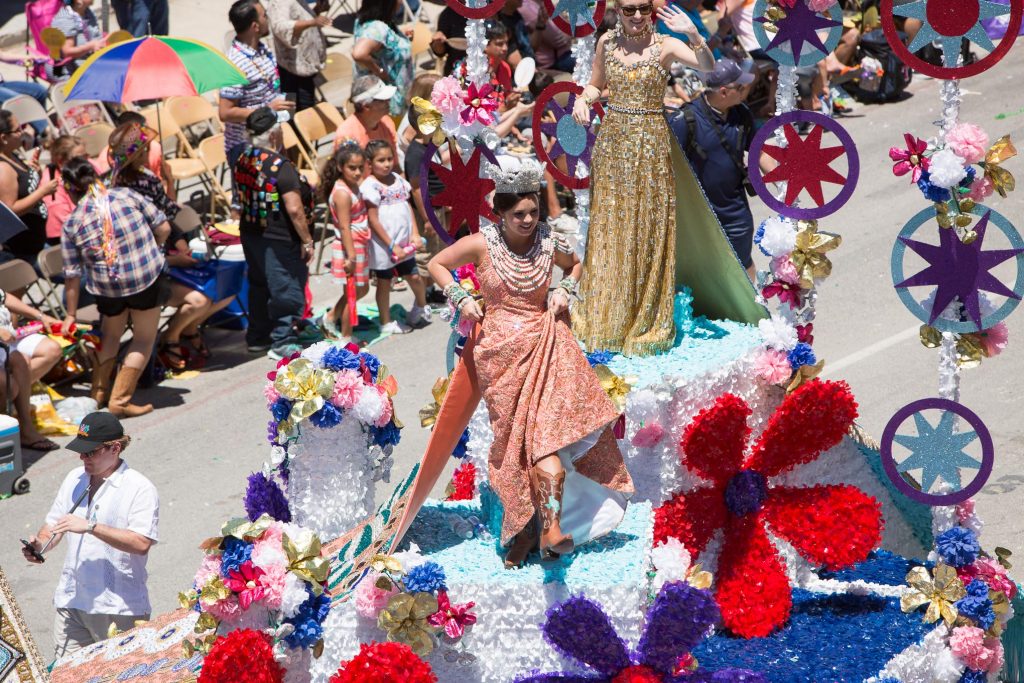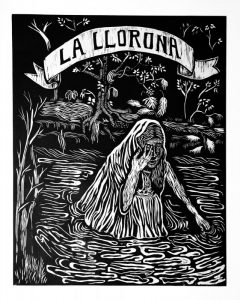Colorful floats; streets closed with barricades; people covering the sidewalks and setting up their lawn chairs to have a good view, having the day off from school; the Marching Bands from High Schools and Universities, decorating their instruments with ribbons, preparing their formation under Highway 37 on Grayson Street; the Fiesta Royalty putting on their best pairs of decorated shoes before stepping onto their throne, mounted on one of the biggest of the parade floats. If you’re a native San Antonian, you know exactly what grand celebration is about occur and what has been going on for the days before; it is part of Fiesta, the ten-day city-wide celebration; it is the Battle of Flowers parade. The Battle of Flowers is a 2.6-mile parade that runs through downtown San Antonio, typically one of the closing events of the Fiesta celebration. This Parades begins on the edge of downtown, and continues onto three major streets: Broadway, Alamo, and Commerce.1 Local schools participate in this parade; their dance troops, mariachi bands, ROTC, and Marching Band programs participate and walk the parade alongside the Texas Cavaliers, the Fiesta Royalty, and the Mayor. Although this annual event has become a hallmark for San Antonians, many don’t know how or when it all began. Let’s go back to its origins, back to the last decade of the nineteenth century in San Antonio.

Originating in 1891, the Battle of Flowers parade was created as a tribute to all those who fought and who fell at the Battles of San Jacinto and the Alamo.2 The idea of a grand celebration to commemorate these heroes came from a tourist, the native-Chicagoan W. J. Ballard. He believed that a proper tribute should be made, and asked a group of local ladies why this had not been the case just yet. His question extended through the city and made its way into newspapers and gained the approval of the community almost instantly. The anticipated idea aroused a spark of interest in Ellen Maury Slayden, a native Virginian elite, who had found her way to San Antonio by marriage to a merchant and later congressman, James L Slayden. Slayden then decided to bring Ballard’s idea to life, and since she knew it was almost impossible on her own, she decided to enlist the help of another newcomer to the area, J. S. Alexander. They both decided to take this on as a pet project of theirs, with the help and support of their husbands. Alexander, a banker before arriving in Texas, provided information on some familiarity he had had overseas about seeing a parade surrounded by flowers, where carts were decorated with flowers. Slayden also remembered similar instances in celebrations she knew about across Mexico and Spain, giving the basis for what the parade would become. The husbands, and many of the elite men of San Antonio, took over the project and had gentlemen speak on behalf of the ladies at the committee meetings; however, as the project grew, the ladies wanted to make sure that it was still a women’s project and continued to provide input and ideas, thus creating the Battle of Flowers Association.3

The parade was originally intended to be an April 21st celebration to celebrate the 55th anniversary of the victory of the Battle of San Jacinto; however, coincidentally, San Antonio was just then expecting its first-ever visit from the White House, the 23rd president of the United States, President Benjamin Harrison. As soon as word got out, the city became ecstatic and prepared a celebration to welcome the President, including moving the parade a day ahead of its original date. With the dates set in stone, the first official planning committee meeting took place only a mere seven days prior to the event. They were frantically trying to gather flowers from nearby towns, since San Antonio had just experienced some heavy rains, which had destroyed most flower gardens, leaving the city with a shortage of flowers just before the parade. Trains were rushed in with shipments of flowers from nearby towns. Other means of making up for the shortage were discussed as well, such as dressing the children up as flowers and having bicyclists decorate their mobiles with whatever blossoms they found and join the parade.4 In the days leading up to the parade, everything seemed all set to go, except for the weather. The city had been plagued with days of heavy rain, and the whole city was hopeful that the rains would cease as the day approached; however, they were wrong. On the morning of the parade, the rains didn’t have mercy on their plans, and as the President’s train arrived, the downpour became continuous. But the rains didn’t stop the city from providing the President with a warm welcome; however, it did postpone the flower parade for the following week, which, of course, would mean that the President would be long gone by then. When the warm weather finally arrived the following week, the parade went as planned; and it was so successful that the committee pushed to have it continue as an annual celebration. It has since been celebrated since 1891, except for the years during World Wars I and II.5

By 1985, the parade continued to grow into the week-long celebration known today as Fiesta. And as the years went by, Kings and Queens were elected as Fiesta Royalty.6 The Parade continues to grow, and so does its recognition across the city and the state. It is now funded by private associations. To this day the parade is one of the closing events of the city-wide, week-long Fiesta party and continues to generate community involvement. Every April, San Antonio puts on a fantastic show, and without a doubt, it all goes back to a Chicagoan tourist, two ladies, and one united community.

- Battle of Flowers, Official Website: Battle of Flowers About us (battleoflfowers.org, 2018). ↵
- Handbook of Texas, June 2010, s.v “Fiesta San Antonio,” by Mrs. Willard E. Simpson, Jr. ↵
- Jack Maguire, A Century of Fiesta in San Antonio (Austin, Texas: Eakin Press, 1990), 13-15. ↵
- Jack Maguire, A Century of Fiesta in San Antonio (Austin, Texas: Eakin Press, 1990), 17. ↵
- Jack Maguire, A Century of Fiesta in San Antonio (Austin, Texas: Eakin Press, 1990), 17; Laura Hernandez-Ehrisman, Inventing the Fiesta City, Heritage and Carnival in San Antonio (New Mexico Press,2008), 21. ↵
- Handbook of Texas, June 2010, s.v. “Fiesta San Antonio,” by Willard E. Simpson, Jr. ↵



117 comments
Regina De La Parra
This has been my first year living in San Antonio and I hope I could have known about this incredible event. I can see that this event has a lot of history and is very important for the people of San Antonio. I found it very interesting how this event in fact celebrates and remembers those soldiers who fought for us and died in battle. Overall this was a great article. Great job Yahaira!
Miranda Alamilla
Honestly, one of the first things that caught my attention about this article was that featured image. It has so much color and so much ambiance you almost feel like you’re at fiesta. The other photos definitely put life into the article, but that first featured image is what really caught my, and probably most other readers attentions. Good Luck!
Tyler Sleeter
Interesting article with lots of information. I had read in Texas Monthly magazine that Fiesta is the second largest celebration in America, behind Mardi Gras. That was impressive to me. I have been to a few of the Fiesta parades over the years and I remember hearing people ask about the shoes, but did not really understand the purpose. I did not know the story behind Fiesta until now. It is interesting to me that the week long celebration grew out of a parade to honor the soldiers from San Jacinto. It is a unique way to honor them, in my opinion.
Hector Garcia
As a newcomer to San Antonio I wasn’t quite sure what the Battle of the Flowers was but through this article, I am excited to attend this unique event that only occurs once a year. I also enjoyed the history that author and how the author was able to display a small part of history from San Antonio. I thought it was a great article and I understand why it was nominated for best in “Cultural History.”
Hannah Wilson
This article is interesting because it does a great job of explaining the culture and meaning of the battle of flowers. It was descriptive and organized. I thought it was cool that you wrote an article about San Antonio and now I know more of the culture about the city that I currently live in. It is also cool that Fiesta is now and I get experience firsthand. Good article.
Lewis Wilson
I really enjoyed reading this article! I do not know a lot of Texas history, and since moving to San Antonio from Scotland I have been trying to learn more about the new city that I am in. This article helped teach me about a critical time in the history of San Antonio. The images in this article are really good and it is clear to see why this article has been nominated in the category for best image. I look forward to attending the parade this year!
Reese Lujan
With the battle of flowers coming up and not knowing much about the culture of it reading this article really helped me grasp the meaning of the origin that it came from. The parade really captures the Mexican culture and incorporates it in the flowers they choose t present. It’s beautiful to know that they use this as a way to celebrate and in remembrance of the soldiers that lost their life in battle. Reading this article has convinced me to go and partake in the battle of the flowers next weekend.
Edgar Ramon
The Battle of the Flowers Parade is a very central thing to San Antonio, not just because of the parade but for tourism. This parade is similar to what you would see in Spain or Mexico, on parades for the days of Saints, or for bullfighters, and other festive dates. It was brought to my attention in another class however that with the Alamo expansion plan, the street through which the Battle of the Flowers parade passes through in front of the Alamo would now be closed to vehicles. Perhaps the parade will adapt, but I just thought this was interesting.
Destiny Leonard
Prior to this article I knew of Battle of the Flowers as the reason why around the time of Oyster Bake we get a half day off from classes, however I never knew what Battle of the Flowers actually was. I am from El Paso and prior to coming out to San Antonio for college I had never known what “Fiesta” was. This article was definitely much needed on my part in order for me to become more familiar with the city I call home while I am attending college. It was surprising for me to see that something which seems to run so deeply in the people of San Antonio’s culture was started by people who did not grow up in San Antonio. overall great article.
Fumei Pinger
I enjoyed this festive piece, especially since the celebration of Fiesta in San Antonio is right around the corner. I’ve lived in San Antonio for the last four years, and I’ve really enjoyed the warm and vibrant atmosphere of the Oyster bake and A Night in Old San Antiono. I’ve never attended the Battle of the Flowers parade, but now I know the history behind it. I think it’s inspiring that someone’s idea was brought to life and celebrated all these years.